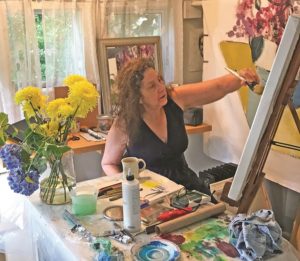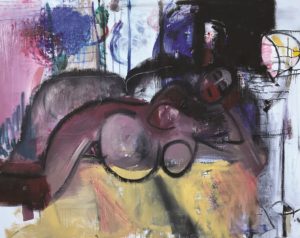What would Hans Hofmann think of Zoom? That may sound like a silly question, but it’s one that is conjured up by Laura Shabott’s paintings at the Berta Walker Gallery in Provincetown, on view through Aug. 8 in a group show with work by Salvatore Del Deo, Romolo Del Deo, and the late Elspeth Halvorsen. Shabott, who was invited to join the gallery this year and who is heavily influenced by the late Hofmann’s teachings, created several pieces in the show during the last few months, using a model who is live online, via Zoom.

Shabott has taken a somewhat circuitous path to becoming a full-time painter. After graduating from the School of the Museum of Fine Arts in 1995, she spent 10 years working in the theater, then 10 more years as an arts writer. She committed to being a visual artist at the age of 57.
“My soul was a painter, and my truest need was to make paintings,” she says. “I have not had one moment of doubt.”
Shabott thinks of her past “not as time wasted, but as history as preparation for this moment.” Indeed, art cannot be created in a vacuum. As an older artist, she says, she can “let go of the investment,” taking risks and experimenting with different styles and media. But she’s always aware of the traditions and influences that precede her.
She describes Hofmann, and his famous push-and-pull technique, as key to her approach to art. She traces her lineage to the great abstract expressionist teacher through her own mentor, Wellfleet artist Robert Henry. Hofmann’s spirit is especially present in Ode to Hofmann #6, a painting in Berta Walker Gallery’s far room.

That piece is part of a series, painted between the winter of 2016 and spring of 2017, all of the same still-life tableau: a clay pitcher, a vase, an ink jar, and palettes. At the same time, it seems to evoke the human form: a foot, a vulva, a face.
Shabott’s analytical nature makes her an excellent teacher as well, especially for older students. In the courses she offers, she emphasizes principles rather than technique, so that students don’t copy a style and, instead, create their own personal language. She is currently teaching a class in push-pull still life at Truro Center for the Arts at Castle Hill, and one in figure drawing at the Provincetown Art Association and Museum. Both are “virtual open life,” held via Zoom.
Indeed, Shabott is not at all averse to new technology. “Since Covid, there has been a real sense of disruption, and I’ve allowed it,” says Shabott. The proof is in works such as Waiting, a four-by-five-foot canvas that graces the Walker Gallery’s front window, one of several pieces in the show to use a model on Zoom.

“This painting had many incarnations, with all of the work for the figure done on Zoom,” she says via email. “The model just had her baby, and this was finished a month before the birth.” The figure’s round belly and breasts are done with such authority, there is not an ounce of hesitation in the bold strokes.
“One benefit of virtual open life is being able to use paint, spread out, and make noise,” Shabott says. “The collage-making sounds of ripping, cutting, and gluing can happen without disturbing a room full of other artists.” Such is the case with He Was a King in a Past Life, which uses fabric, found materials, oil paper, and archival glue.
Though it’s not apparent that Waiting arose from a subject on Zoom, there is something eerie and beguiling about Window, another painting in the show. “Zoom open life reduces the figure to a screen the size of a laptop, so the model feels as if they are in an alternate reality,” Shabott says.
In Window, white oil pastel lines suggest dimensionality, but the perspective feels alien. The figure thrusts forward, as if part of a diorama, and the window is surrounded by a halo of light. A plug socket on the wall reminds the viewer of how the painting came about.

Aglow, another Zoom work, similarly focuses on light. The reds, whites, and teals in the figure cause it to come forward. The title of the piece gains new meaning when one realizes that the computer screen from which it was painted is a source of light.
In these works, Shabott combines Hofmann’s basic tenets — light, color, dimensionality, form — with the technology of the 21st century. But they mesh well: the computer screen is, after all, just another rectangle, another frame, like a window or doorway.
And the eye always perceives some degree of separation between itself and the object, whether it be the air, glass, or, in this case, an electronic screen. Shabott views painting from Zoom simply and directly: “Everything I paint is from life,” she says.
Model Behavior
The event: An exhibit of artwork by Laura Shabott, along with work by Salvatore Del Deo, Romolo Del Deo, and Elspeth Halvorsen
The time: Through Aug. 8; gallery open by appointment (calendly.com/bertawalker), Wednesday-Saturday, noon to 4 p.m.
The place: Berta Walker Gallery, 208 Bradford St., Provincetown
The cost: Free



